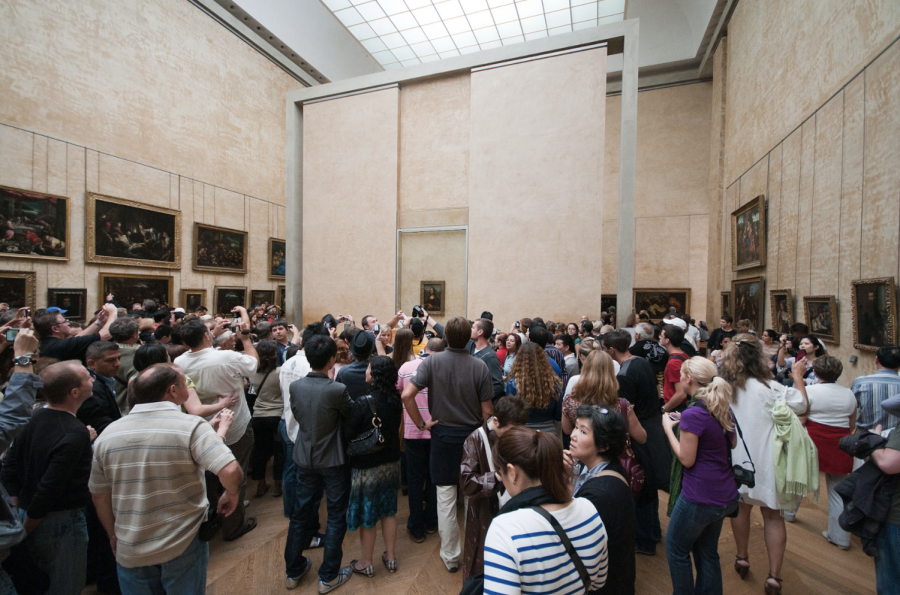Modern art lowers artistic standards and limits human expression
Crowds joyously wait for a chance to view the Mona Lisa, a true artistic masterpiece
October 5, 2022
Perhaps, in this cascade of modern political discourse, we tend to disregard issues that don’t impact our immediate lives. While paying taxes or going to school is of paramount importance, it is also essential to examine the culture of our postmodern world. The most visible and remarkable hallmark of any epoch is its contributions to the arts, not just paintings, but the arts more broadly understood. This would include writing, music, paintings, and even shows, which in a bygone time would have been primarily operas, but are today replaced by campier musicals. In the modern world, the standard for the arts has declined, which in turn, has allowed detritus to adorn the walls of museums and play out on the stages of the world. While some of this modern art might glister, it is important to remember the wise words of William Shakespeare “all that glisters in not gold.”
The arts show a society the ideal version of itself, which is beautiful and appeals to natural feelings. In antiquity, the Mesopotamians built ziggurats, which looked different from all other architectural structures they had previously built and were physically tall, to make one feel near to the gods. The early Western historian Herodotus even said that the ziggurats had shrines to the gods on the top of them. These architectural wonders have stood out from age to age because of their magnificence and their departure from mundanity. Many other religions have since followed the Mesopotamians and built distinct structures for their worship, from the Jewish temple in Jerusalem to the spectacular Catholic cathedral Notre Dame in Paris. While standing out from their surroundings, these buildings also appeal to a natural interest, namely that of worshiping a higher power. These marvels bring out the deepest yearnings in each of us and remind us that in the words of Hamlet, “there are more things in Heaven and Earth, Horatio, than are dreamt of in your philosophy.”
Leonard da Vinci’s Mona Lisa is a classic example of true art in the sense of being natural. The Mona Lisa is not beautiful because she is wearing the Hope Diamond, but because she is natural and too perfect for this world. The Mona Lisa highlights the best version of beauty and shows it in its simplicity. The 19th and 20th century painter Claude Monet also highlighted natural beauty in his paintings of water lilies. These paintings call to mind the serenity of nature and again speak to the inner longing for peace and tranquility. Though simple, the paintings are elaborate in their design and show us what the most perfect state of nature might be, undisturbed by the movements of the world. While all art has been different throughout history, the common standard of what art represents has almost always been upheld by every culture.
The biggest declension in art has been in the theater. Plays have long been a part of many cultures and have roots back in antiquity. Great writers, such as Sophocles, Shakespeare, and Tennessee Williams all have been part of the arc of theatrical history. Operas too have been integral in much of art and have given us resounding choruses such as Figaro and the Hallelujah chorus. In the late 19th century, playwrights began combining these two artistic forms into one, thus giving birth to the modern musical. Musicals are unique, in that they combine both acting and singing, therefore, forcing the composers to work in tandem, while writing dialogue and composing tunes. This is a pure form of art, which many, including myself, are not capable of even attempting. However, in recent times, a new popular form of musicals, which neglect the unique quality of past classics, have sprung up: “jukebox musicals.” These new musicals take classic songs and throw them together with dialogue written around the songs. One such musical All Shook Up, which was composed in 2004, does this in an explicitly bad manner. The show focuses on a rebellious man who gets stranded in a typically Christian southern town in the 1950s and turns the town towards the counterculture of the time. While the plot sounds appealing, the music is all Elvis tunes and has no originality. The play, therefore, comes across as a concert with some intermittent dialogue in it. The absence of originality and the imbalance of music and talk makes the show less than satisfactory. The triteness of these types of musicals lowers their status from an art to something that anybody can make. The notion that if I make a few lines of dialogue between Johnny and Sue and throw in Old Suzanna, I made a musical, is preposterous and should incur the anger of anybody who has reverence for the arts.
While what is artistically popular does change, the standards that art must meet, should remain constant. Modern art lowers the standards of art and corrupts its original intent to show us the beauty around us. It is certain that most modern artists do not desire to craft ugly images and works, but they should not be cheered on as though they were the next da Vinci or Monet. As we ponder the art in the world around us, we should remember the words of the 18th century poet Alexander Pope: “All nature is but art, unknown to thee; All chance, direction, which thou canst not see.”



